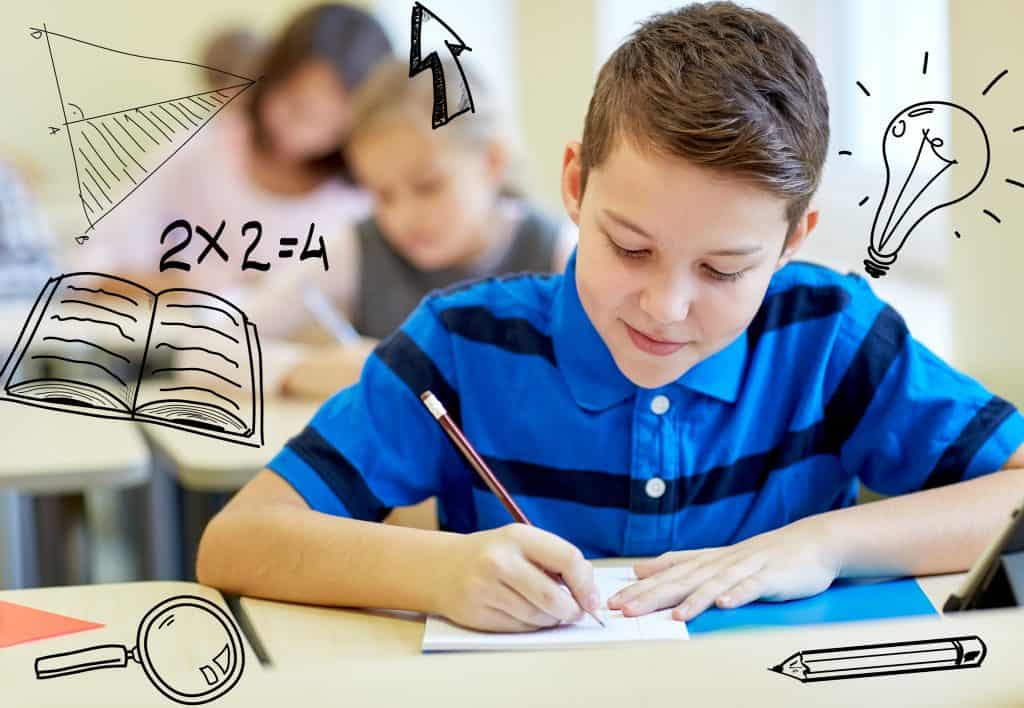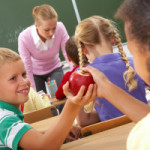
Old Fashioned Mom brings you Harpers BAZAAR.. Food Diaries with Yolanda Hadid

Old Fashioned Mom brings you Harpers BAZAAR.. Food Diaries with Yolanda Hadid

Support from parents is key to helping kids do well academically. Here are 10 ways parents can put their kids on track to be successful students.

Kids do better in school when parents are involved in their academic lives. Attending back-to-school night at the start of the school year is a great way to get to know your child’s teacher and his or her expectations. School administrators may discuss school-wide programs and policies, too.
Attending parent-teacher conferences is another way to stay informed. These are usually held once or twice a year at progress reporting periods. The conferences are a chance to start or continue conversations with your child’s teacher, and discuss strategies to help your child do his or her best in class. Meeting with the teacher also lets your child know that what goes on in school will be shared at home.
If your child has special learning needs, additional meetings can be scheduled with teachers and other school staff to consider setting up or revising individualized education plans (IEPs), 504 education plans, or gifted education plans.
Keep in mind that parents or guardians can request meetings with teachers, principals, school counselors, or other school staff any time during the school year.
Knowing the physical layout of the school building and grounds can help you connect with your child when you talk about the school day. It’s good to know the location of the main office, school nurse, cafeteria, gym, athletic fields, playgrounds, auditorium, and special classes.
On the school website, you can find information about:
Many teachers maintain their own websites that detail homework assignments, test dates, and classroom events and trips. Special resources for parents and students are also usually available on the district, school, or teacher websites.

Homework in grade school reinforces and extends classroom learning and helps kids practice important study skills. It also helps them develop a sense of responsibility and a work ethic that will benefit them beyond the classroom.
In addition to making sure your child knows that you see homework as a priority, you can help by creating an effective study environment. Any well-lit, comfortable, and quiet workspace with the necessary supplies will do. Avoiding distractions (like a TV in the background) and setting up a start and end time can also help.
A good rule of thumb for an effective homework and/or study period is roughly 10 minutes per elementary grade level. Fourth-graders, for example, should expect to have about 40 minutes of homework or studying each school night. If you find that it’s often taking significantly longer than this guideline, talk with your child’s teacher.
While your child does homework, be available to interpret assignment instructions, offer guidance, answer questions, and review the completed work. But resist the urge to provide the correct answers or complete the assignments yourself. Learning from mistakes is part of the process and you don’t want to take this away from your child.
A nutritious breakfast fuels up kids and gets them ready for the day. In general, kids who eat breakfast have more energy and do better in school. Kids who eat breakfast also are less likely to be absent, and make fewer trips to the school nurse with stomach complaints related to hunger.
You can help boost your child’s attention span, concentration, and memory by providing breakfast foods that are rich in whole grains, fiber, and protein, as well as low in added sugar. If your child is running late some mornings, send along fresh fruit, nuts, yogurt, or half a peanut butter and banana sandwich. Many schools provide nutritious breakfast options before the first bell.
Kids also need the right amount of sleep to be alert and ready to learn all day. Most school-age kids need 10 to 12 hours of sleep a night. Bedtime difficulties can arise at this age for a variety of reasons. Homework, sports, after-school activities, TVs, computers, and video games, as well as hectic family schedules, can contribute to kids not getting enough sleep.
Lack of sleep can cause irritable or hyper types of behavior and might make it difficult for kids to pay attention in class. It’s important to have a consistent bedtime routine, especially on school nights. Be sure to leave enough time before bed to allow your child to unwind before lights out and limit stimulating diversions like TV, video games, and Internet access.

When kids are organized, they can stay focused instead of spending time hunting things down and getting sidetracked.
What does it mean to be organized at the elementary level? For schoolwork, it means having an assignment book and homework folder (many schools supply these) to keep track of homework and projects.
Check your child’s assignment book and homework folder every school night so you’re familiar with assignments and your child doesn’t fall behind. Set up a bin for papers that you need to check or sign. Also, keep a special box or bin for completed and graded projects and toss papers that you don’t need to keep.
Talk to your child about keeping his or her school desk orderly so papers that need to come home don’t get lost. Teach your child how to use a calendar or personal planner to help stay organized.
It’s also helpful to teach your child how to make a to-do list to help prioritize and get things done. It can be as simple as:
No one is born with great organizational skills — they need to be learned and practiced.
Studying for a test can be scary for young kids, and many educators assume parents will help their kids during the grade-school years. Introducing your child to study skills now will pay off with good learning habits throughout life.
In elementary school, kids usually take end-of-unit tests in math, spelling, science, and social studies. Be sure to know when a test is scheduled so you can help your child study ahead of time rather than just the night before. You also might need to remind your child to bring home the right study materials, such as notes, study guides, or books.
Teach your child how to break down overall tasks into smaller, manageable chunks so preparing for a test isn’t overwhelming. You also can introduce your child to tricks like mnemonic devices to help with recalling information. Remember that taking a break after a 45-minute study period is an important way to help kids process and remember information.
Your child probably will be introduced to standardized testing in elementary school. While students can’t really study for standardized tests, some teachers provide practice tests to help ease students’ worries.
In general, if studying and testing becomes a source of stress for your child, discuss the situation with the teacher or school counselor.

Schools usually cite their disciplinary policies (sometimes called the student code of conduct) in student handbooks. The rules cover expectations, and consequences for not meeting the expectations, for things like student behavior, dress codes, use of electronic devices, and acceptable language.
The policies may include details about attendance, vandalism, cheating, fighting, and weapons. Many schools also have specific policies about bullying. It’s helpful to know the school’s definition of bullying, consequences for bullies, support for victims, and procedures for reporting bullying.
It’s important for your child to know what’s expected at school and that you’ll support the school’s consequences when expectations aren’t met. It’s easiest for students when school expectations match the ones at home, so kids see both environments as safe and caring places that work together as a team.
Whether kids are just starting kindergarten or entering their last year of elementary school, there are many good reasons for parents to volunteer at school. It’s a great way for parents to show they’re interested in their kids’ education.
Many grade-schoolers like to see their parents at school or at school events. But follow your child’s cues to find out how much interaction works for both of you. If your child seems uncomfortable with your presence at the school or with your involvement in an extracurricular activity, consider taking a more behind-the-scenes approach. Make it clear that you aren’t there to spy — you’re just trying to help out the school community.
Parents can get involved by:
Check the school or teacher website to find volunteer opportunities that fit your schedule. Even giving a few hours during the school year can make an impression on your child.
Sick kids should stay home from school if they have a fever, are nauseated, vomiting, or have diarrhea. Kids who lose their appetite, are clingy or lethargic, complain of pain, or who just don’t seem to be acting “themselves” should also take a sick day.
Otherwise, it’s important that kids arrive at school on time every day, because having to catch up with class work and homework can be stressful and interfere with learning.
If your child is missing a lot of school due to illness, make sure to check with the teacher about any work that needs to be completed. It’s also a good idea to know the school’s attendance policy.
Sometimes students want to stay home from school because of problems with classmates, assignments or grades, or even teachers. This can result in real symptoms, like headaches or stomachaches. If you think there’s a problem at school, talk with your child — and then perhaps with the teacher — to find out more about what’s causing the anxiety. The school counselor or school psychologist also might be able to help.
Also try to avoid late bedtimes, which can result in tardy and tired students. A consistent sleep schedule can help.

It’s usually easy to talk with elementary students about what’s going on in class and the latest news at school. You probably know what books your child is reading and are familiar with the math being worked on. But parents can get busy and forget to ask the simple questions, which can have an effect on children’s success at school.
Make time to talk with your child every day, so he or she knows that what goes on at school is important to you. When kids know parents are interested in their academic lives, they’ll take school seriously as well.
Because communication is a two-way street, the way you talk and listen to your child can influence how well your child listens and responds. It’s important to listen carefully, make eye contact, and avoid multitasking while you chat. Be sure to ask questions that go beyond “yes” or “no” answers.
Besides during family meals, good times to talk include car trips (though eye contact isn’t needed here, of course), walking the dog, preparing meals, or standing in line at a store.
These early years of schooling are an important time for parents to be informed and supportive about their child’s education.

Reviewed by: D’Arcy Lyness, PhD


Eva Longoria has been an actress, a producer, and an activist, but now, she’s taking on a brand-new role as a first-time mom.
On Tuesday, Longoria welcomed a baby boy named Santiago Enrique with her husband Jose Antonio Bastón.
Eva and Jose shared the first photo of their little boy with Hola! USA, telling the site, “We are so grateful for this beautiful blessing.”

In March, she talked about how she intends to raise a feminist son.
“I’m so excited that I’m having a boy because I think the world needs more good men,” she said in an Instagram video on International Women’s Day.
“This boy, my son, will be surrounded by very strong, educated, powerful women and I think it’s important that he sees those types of role models in his life so he knows how to support it, how to applaud it and how to honor it.”
The new mom is currently hard at work directing episodes of Black-ish and producing the ABC drama pilot Grand Hotel. She continued to work far into her pregnancy, posting pictures of herself on set up until this month.
Written By: Alexandra Whittaker

BY: STEPHANIE PETIT and LIZ MCNEIL


Prince Albert ll of Monaco, Princess Caroline and Princess Stéphanie posed together at a celebration on the eve of what would have been their mother’s 88th birthday. The siblings gathered in front of the Theatre Princess Grace as the Princess Grace Foundation-USA celebrated the 35th anniversary of the foundation that honors her legacy.
The event featured a screening of The Country Girl, for which Princess Grace won the Academy Award for Best Actress in 1955.
It’s been 35 years since Princess Grace — who wed Prince Rainier of Monaco in 1956 — died tragically after suffering a stroke while driving back to Monaco from the royal family’s country home on Sept. 13, 1982. She lost control of the car and drove off of a steep mountainside. When paramedics arrived, she was in critical condition.
She and her then-17-year-old daughter, Stéphanie, were transported to the hospital, where Grace later succumbed to her injuries. Stéphanie suffered a concussion and fractured vertebra.

Prince Albert and his mother, Princess Grace, in 1974
Recalling the tragic day in a recent interview with Graham Bensinger, Albert said he was having breakfast when his father came in to tell him about the crash.
“Basically, he said that we had to go down to the hospital because mom and Stéphanie had an accident,” Albert said. “And so I didn’t think twice about it and went down with him and [sister] Caroline as well.
He continued, “It was a very shocking moment, you’re not quite sure what to think, and of course, you think that things are going to improve and it’s not as bad an accident as you thought it was. And so those few hours there were very tense and very emotional.”

Grace Kelly’s children have gathered together for a rare, new family photo
Albert also spoke out about Stéphanie’s recovery and how she came to terms with her mother’s death.
“It took a very long time for her to recover from this, and it was a very painful recollection for her,” Albert said. “It took a number of years for her to come to terms with that — the pain of being in that car with our mother and not being able to pull her out or to have a different outcome.
He added, “It was a traumatic experience and would be for everybody.”
As for their father, “He was deeply affected and he wasn’t quite the same man as he was before the accident.”

Baby and Nepal have also found fans in Prince Jacques and Princess Gabriella, Albert’s 2-year-old twins with Princess Charlene, who “visit across the road regularly and know what elephants are now.” The siblings are animals lovers themselves: Their own farmhouse menagerie includes dogs, chickens, cows and llamas.

Stephane Cardinale
Prince Albert also recently gushed to PEOPLE of his other sister, Princess Caroline, calling her “quite a remarkable woman.”
“What’s she’s done over the years, helping Monaco in various ways, on the cultural and charitable sides — she’s always there. She’s often the first person on board.”

Bill Gates, Father of three adorable children shares his love of books. Reading is crucial and the backbone to everything we do in life….here are some of his favorites.
~My Favorite Books~
By Bill Gates
Never before have I felt so empowered to learn as I do today. When I was young, there were few options to learn on my own. My parents had a set of World Book Encyclopedias, which I read through in alphabetical order. But there were no online courses, video lectures, or podcasts to introduce me to new ideas and thinkers as we have today.
Still, reading books is my favorite way to learn about a new topic. I’ve been reading about a book a week on average since I was a kid. Even when my schedule is out of control, I carve out a lot of time for reading.
If you’re looking for a book to enjoy, here are some of my favorites from this year. They cover an eclectic mix of topics—from tennis to tennis shoes, genomics to great leadership. They’re all very well written, and they all dropped me down a rabbit hole of unexpected insights and pleasures.
String Theory, by David Foster Wallace. This book has nothing to do with physics, but its title will make you look super smart if you’re reading it on a train or plane. String Theory is a collection of five of Wallace’s best essays on tennis, a sport I gave up in my Microsoft days and am once again pursuing with a passion. You don’t have to play or even watch tennis to love this book. The late author wielded a pen as skillfully as Roger Federer wields a tennis racket. Here, as in his other brilliant works, Wallace found mind-blowing ways of bending language like a metal spoon.
Shoe Dog, by Phil Knight. This memoir, by the co-founder of Nike, is a refreshingly honest reminder of what the path to business success really looks like: messy, precarious, and riddled with mistakes. I’ve met Knight a few times over the years. He’s super nice, but he’s also quiet and difficult to get to know. Here Knight opens up in a way few CEOs are willing to do. I don’t think Knight sets out to teach the reader anything. Instead, he accomplishes something better. He tells his story as honestly as he can. It’s an amazing tale.
The Gene, by Siddhartha Mukherjee. Doctors are deemed a “triple threat” when they take care of patients, teach medical students, and conduct research. Mukherjee, who does all of these things at Columbia University, is a “quadruple threat,” because he’s also a Pulitzer Prize– winning author. In his latest book, Mukherjee guides us through the past, present, and future of genome science, with a special focus on huge ethical questions that the latest and greatest genome technologies provoke. Mukherjee wrote this book for a lay audience, because he knows that the new genome technologies are at the cusp of affecting us all in profound ways.
The Myth of the Strong Leader, by Archie Brown. This year’s fierce election battle prompted me to pick up this 2014 book, by an Oxford University scholar who has studied political leadership—good, bad, and ugly—for more than 50 years. Brown shows that the leaders who make the biggest contributions to history and humanity generally are not the ones we perceive to be “strong leaders.” Instead, they tend to be the ones who collaborate, delegate, and negotiate—and recognize that no one person can or should have all the answers. Brown could not have predicted how resonant his book would become in 2016.
Honorable mention: The Grid, by Gretchen Bakke. This book, about our aging electrical grid, fits in one of my favorite genres: “Books About Mundane Stuff That Are Actually Fascinating.” Part of the reason I find this topic fascinating is because my first job, in high school, was writing software for the entity that controls the power grid in the Northwest. But even if you have never given a moment’s thought to how electricity reaches your outlets, I think this book would convince you that the electrical grid is one of the greatest engineering wonders of the modern world. I think you would also come to see why modernizing the grid is so complex and so critical for building our clean-energy future.

Old Fashioned Mom Magazine hosted a VIP Soiree at The Skylark.
This intimate gathering included, Sabrina Baldieri, Lauren Lawrence, Alessandra Emanuel, Joy Marks, Elizabeth Washer, Laura Bounin and Michelle-Marie Heinemann.
The Septet celebrated the OFM lifestyle brand at The Skylark which provided the most fantastic views of the City.
Set thirty stories up in the heart of Times Square South, The Skylark delivers a classically-styled cocktail lounge with expansive panoramic views of the Hudson River, Hudson Yards, Times Square, The Empire State Building, and the best of Midtown Manhattan.
With its multi-level indoor spaces, open-air rooftop terrace and warm furnishings — designed by Meyer Davis Studio — The Skylark is a truly all-season destination. In cooler months, guests can enjoy breathtaking city views from the main lounge’s floor-to-ceiling windows. Warmer days deliver an experience that flows naturally between the indoor and outdoor spaces.
Drinks and food at The Skylark are as distinctive as the space itself. The exclusive mixologist’s cocktail menu is based on classic inspirations that are rendered using only the freshest ingredients. The light fare options include a variety of small plates – perfect for an after-work or evening bite.
I throughly enjoyed several of these Harvest Cobbler’s handcrafted by master mixologist Johnny Swet. It includes; Titos Vodka, Marilde Pear Liquor, Pear and Rosemary.
The Skylark was developed by hospitality veteran David Rabin together with Jim Kirsch and Alison Awerbuch of Abigail Kirsch.
…..until the next OFM Soirée!
~The Skylark~
212-257-4577
200 West 39th Street
30th Floor
www.theskylarknyc.com

Kids are more successful in school when parents take an active interest in their homework — it shows kids that what they do is important.
Of course, helping with homework shouldn’t mean spending hours hunched over a desk. Parents can be supportive by demonstrating study and organization skills, explaining a tricky problem, or just encouraging kids to take a break. And who knows? Parents might even learn a thing or two!
Here are some tips to guide the way:
1.Know the teachers — and what they’re looking for. Attend school events, such as parent-teacher conferences, to meet your child’s teachers. Ask about their homework policies and how you should be involved.
2. Set up a homework-friendly area. Make sure kids have a well-lit place to complete homework. Keep supplies — paper, pencils, glue, scissors — within reach.
3. Schedule a regular study time. Some kids work best in the afternoon, following a snack and play period; others may prefer to wait until after dinner.
4. Help them make a plan. On heavy homework nights or when there’s an especially hefty assignment to tackle, encourage your child break up the work into manageable chunks. Create a work schedule for the night if necessary — and take time for a 15-minute break every hour, if possible.
5. Keep distractions to a minimum. This means no TV, loud music, or phone calls. (Occasionally, though, a phone call to a classmate about an assignment can be helpful.)
6. Make sure kids do their own work. They won’t learn if they don’t think for themselves and make their own mistakes. Parents can make suggestions and help with directions. But it’s a kid’s job to do the learning.
7. Be a motivator and monitor. Ask about assignments, quizzes, and tests. Give encouragement, check completed homework, and make yourself available for questions and concerns.

8. Set a good example. Do your kids ever see you diligently balancing your budget or reading a book? Kids are more likely to follow their parents’ examples than their advice.
9. Praise their work and efforts. Post an aced test or art project on the refrigerator. Mention academic achievements to relatives.
10. If there are continuing problems with homework, get help. Talk about it with your child’s teacher. Some kids have trouble seeing the board and may need glasses; others might need an evaluation for a learning problem or attention disorder.

Ways to help your children develop empathy, kindness and a sense of responsibility toward others.
While rummaging through an old box, my daughter, Claire, came across the stuffed bear I’d had when I was her age, a deeply loved creature named Teddy. “How come Teddy has no fur?” she asked. “Why doesn’t she have eyes?” I explained that my cousin’s dog had chewed up Teddy when I was a kid. She was aghast.
Gravely, she kissed Teddy’s empty eye sockets. Somberly, she reported to her twin brother, Drew, what had happened. “We’ve got to fix her,” she said.
As it turns out, children have an inborn capacity for compassion. Small in stature themselves, they naturally identify with stuffed animals, other kids, pets, and underdogs. The tricky part is that their empathy must compete with other developmental forces, including limited impulse control—which makes them pull the cat’s tail—and their belief that their needs absolutely must come first—which makes it hard for them to let their cousin push the cool fire truck.
But with so much hatred and turmoil in the world today, it seems more important than ever to raise kids who can understand and be kind to other people. Tea
ching this doesn’t mean lectures or visits to soup kitchens. It’s part of day-to-day life: how you answer your child’s questions, how you solve conflict at the park, how you nudge his or her growing capacity to understand and think about other people. Temperament of course plays a role—some kids are naturally more tuned in to other people’s feelings and difficulties, while others are a bit oblivious. Either way, you have influence in fostering your child’s ability to empathize. Age by age, here’s how to do so in small, daily doses:
Promote sweetness
Teaching your child ways to treat things with care helps him develop the understanding that actions have consequences.
Show how to be gentle. Your child wants to be friendly but ends up grabbing the baby roughly? Demonstrate another way. “I say, ‘We use our hands to give love,'” says Kimberly Mazone of Dresden, Maine, mother of 4-year-old Sienna and 3-month-old Lucca. “‘You’re being a little bit rough. Let’s be gentle. Let’s show our love with our hands.'” You can actually take his hand and show him physically what a gentle touch is.
Speak softly. Your kindness will be a role model for how to treat others. When your child’s in pain, be warm and caring. “It’s all about the tone in your voice,” says Emily Mihalchik, a mom of 2-year-old Sam and director of the Johnnie Appleseed Preschool, in Lawrence, Kansas. If a child’s friend is crying, “I say, ‘Maybe a hug would be nice,'” says Mihalchik. Young toddlers don’t have a very consistent long-term memory, so you’ll have to repeat your lessons more times than you thought possible.
Reject rudeness. “I see fifteen-month-olds who do things like spit into their parents’ faces, and the parents laugh,” says Susan Jensen, a mom of two and director of Children’s Nook preschool, in North Charleston, South Carolina. This will not do. Compassion requires that your child respect others, including you. Gently but firmly, say “No, you may not spit!” In the same loving but no-nonsense manner, remove his little feet from the table and unlock his fist from your hair.
Say “I’m sorry.” If you’ve been short-tempered with your child, apologize to him. All parents make mistakes. It’s how you address them afterward that makes the difference. He’ll learn that everyone, even Mom, admits it when she’s wrong.
Enforce rules
Consistent limits help your toddler see that her behavior (and misbehavior!) affects others.
Provide structure. It might seem that if you want to raise a compassionate, caring child, you just have to be a compassionate, caring parent. But that’s not enough. Even the most nurturing, loving parenting requires firm limits on behavior, or you’ll get very self-centered children, says Janice Cohn, Ph.D., author of Raising Compassionate, Courageous Children in a Violent World. Make unacceptable behavior, like hitting, always unacceptable—even if it’s her birthday. If something is wrong it has to be wrong all the time.
Expect her to help. When their neighbors are away, Karen Semple’s four kids in Montana City, Montana, take care of the left-behind cats, dogs, and horses. Everyone’s included in helping, and when the youngest was 2, she scooped cat food out of a bag. Rain, snow, and cold weather don’t stop them. For Semple, it’s all about teaching the Golden Rule. “You need to love your neighbor as yourself, even if you don’t particularly feel like it,” she says.
Use manners to connect. With the exciting (and noisy!) arrival of the garbage truck, talk about how we’re all connected: The farmer grows the food, we throw out the peels or waste, and the trash collector picks it up. If your child’s out watching the trash collector, she can say “thank you.” Good manners, which keep us coexisting harmoniously, are one way to show compassion. As much as you can with a squirmy toddler, make good manners part of her daily routine.
“Habits like this can help form character,” says the Reverend Dr. Julia Gatta, an Episcopal priest and associate professor of pastoral theology at the University of the South in Sewanee, Tennessee. “There’s another person at the other end of the relationship who has feelings and deserves respect.”
Guide friendship
Stay tuned in during playtime so you can help your child figure out how to be a friend.
Outlaw name-calling. Compassion starts with what’s acceptable and what’s not. “A little guy called someone a ‘poo-poo head,'” says Jensen. “Immediately, he had to go to time-out or come up to see me. I told him, ‘I know you know that word is unacceptable.'” Explain to her—often—that being kind to others is the rule. You can tell her when she gets into a tiff, “You don’t have to like that person, but everyone has to be nice.”
Give consequences. If the be-nice rule is broken, stick with simple, concrete consequences such as a brief time-out or losing a special toy for a day. A 3-year-old’s abstract thinking is weak, so she’s too young to understand that being nice is morally the right thing to do; your efforts, therefore, should be directed at helping her resist impulses so she won’t get in trouble.
Label kindness. When you catch your child offering a shovel to a friend in the sandbox, label her actions by saying “What a good friend you are,” or “You’re very thoughtful.” Over time, she’ll understand that being a helpful friend, sister, neighbor, and human being is something you value.
Be considerate yourself. While it’s tempting to hand out birthday-party invitations at the park instead of going to the trouble of mailing them, explain to your child that kids who see other children getting invitations but don’t receive one themselves may feel hurt. And all through the year, get her in the habit of sending cards to friends and relatives who could use a kind word: thank-you notes, sympathy cards, get-well wishes. For a child not yet up to writing a message, even a drawing is great.
Don’t trash talk. Kids, as we know, are always listening. How we talk on a daily basis about our own siblings, parents, and relatives tells them a lot. If children hear us saying something really negative about Grandma, they learn that it’s okay to talk that way, says Suzanne Coyle, Ph.D., a mom and director of the Marriage and Family Therapy Program at Christian Theological Seminary in Indianapolis. So keep meanness in check: “Show them you have a spirit of kindness and generosity.”
Encourage helping
With their increasing awareness and independence, preschoolers are ready to participate, if you show them how.
Give pennies. Kids want to feel they can make a difference, so bring charity down to their level. “Every week the children bring in pennies and count them,” says Nancy Manewith, director of the Board of Jewish Education Early Childhood Centers of Metropolitan Chicago. “It’s just part of our pre-math program.” Then the pennies go to charity or to buy mittens and scarves for poor children, which opens the door to conversations about war and poverty.
When talking to your own child about such things, be honest, but don’t feel you have to include every scary detail. Keep explanations simple, and ask simple questions, like “How can we help them?” If his al-lowance is five dimes, ask him how many dimes he’d like to set aside to give to a food bank or drop in a collection jar. Giving him the choice will make him more excited about the idea.
Assign chores. The habit of helping others starts with chores at home. Children love to feel capable, so assign a manageable task like setting the table or feeding the cat. Make a schedule and put it on the fridge so your child can keep track of what he needs to do. When her kids ask why they have to do chores, Anna Notation-Rhoades of Sewanee, Tennessee, a mom of five, tells them “we’re all part of the family, so by helping the family we’re helping ourselves.”
Use stories. Reading books together can be a natural way to help your child start to understand that children aren’t all the same. Books like Faith the Cow, by Susan Bame Hoover, about how the gift of a cow can change the life of a poor family, or Houses and Homes, by Ann Morris, which has photos of houses around the world, can show that kids in other countries want the same things: to feel safe, to be liked, to learn things, to have fun, and to be with their families.
Point out heroes. The siren of a fire truck, not to mention a newspaper photograph of a bomb attack, can make a 4-year-old worry. Shield him from disturbing images as much as possible, but when he hears or sees something frightening, focus the conversation on the firefighters, rescue workers, doctors, or volunteers who are there to help us.
Build on their smarts
Your child’s made cognitive and emotional leaps—help him understand others’ feelings.
Explore feelings. With an increasing vocabulary, a 6-year-old is able to communicate more about emotions. Talking about book characters is a good way to help. “We’d read Snow White and I’d ask, ‘Why do you think the witch was jealous of Snow White?'” says Rev. Gatta, who’s also a mom of a 12-year-old. “Later, maybe in the car, we’d talk about characters’ motives and feelings.”
Monitor media. If the characters on television are hitting each other or calling each other names, shut off the TV or, at least, talk about what’s going on. Children don’t just watch TV, they internalize it, and they don’t get irony, so be careful of what they’re memorizing.
Expect more. When it comes to your child’s responsibility to be caring and compassionate, set your standards high. Don’t let teasing or bullying go unaddressed. At 7 and 8, kids are starting to be able to see the world from another person’s perspective. In a complicated and troubled world, it’s easy to feel that nothing we do will make a difference. This can lead to compassion burnout—for us and for our kids. The key is to start small.
As for my battered Teddy, it was a very small problem in search of a solution. So we repaired her. Claire chose blue felt for her eyes and pink for her nose. She cut out the shapes, which made them interesting to behold. Teddy’s not her old furry self, but she’s much improved. Now, years later, every time Claire hugs my old bear, she knows she made a difference.

Celebrity Mom Jennifer Garner talks about being great friends with Ben Affleck, and making her family a priority.
When it comes to family and her relationship with Ben Affleck, Jennifer Garner only sees one solution. The Nine Lives actress has been separated from her famous ex for more than a year, but the pair still consider themselves a unit for the sake of their three children.
“It has to be. You don’t have a choice. It has to be,” she said during a Thursday morning interview on the Today Show. “We are definitely a modern family. We’re doing really well.”
The former couple recently spent a lot of time together in Europe.
“Ben was working in London on Justice League, and I thought, ‘Well, the kids should have that experience,’” Garner said of the family’s travels. “He and I are great friends, and we just all went en masse.”
The pair announced their separation in June 2015, one day after their 10th wedding anniversary.
A source previously told ET that the spouses are “making it work” and have yet to officially file for divorce.
Last February, Garner opened up to Vanity Fair in a tell-all interview, talking about her marriage to Affleck.
“I didn’t marry the big fat movie star; I married him,” she said at the time. “And I would go back and remake that decision. He’s the love of my life. What am I going to do about that?”


Madame Tussaud pales in comparison to the Living Wax Museum, presented by the 3rd grade at the private Dutchess Day School. Students stood frozen with pride as they became one with their favorite famous American….citing “fun facts” and “historical trivia” in front of a giant paper backdrop.
Old Fashioned Fun was at work, as attendees had to push a button to hear the interesting information, and once pushed it was amazing to learn details of the famous Americans.
Hudson Cornelius Heinemann chose Duke Ellington, the composer, pianist and bandleader. In true Ellington style Hudson sported spectators by A. Testoni and a dapper Merlot wide stripped button down, for his Ellington look.
Ellington’s career spanned 50 years composing masterpieces like “It don’t mean anything, if it ain’t got that swing” and “Prelude to a kiss.” He was a 12 time Grammy award winner and really knew how to get the crowd moving with unique jazz melodies. The project was in true Old Fashioned Mom style as students had to pull a book out of the library and use an encyclopedia to learn about bibliographies.
The Head Mistress, Nancy Hathaway perused each wax figure while other notable Americans included: Amelia Earhart, Edger Allan Poe, Babe Ruth, Arthur Ashe, Betsey Ross, and Sacajawea. “This was a great project, I enjoyed making my backdrop and studying about Duke Ellington. I feel I became more connected with him, as opposed to just googling his name, definitely more interesting to go to the library.” said Hudson Heinemann.

Hudson Heinemann

Duke Ellington

Head Mistress, Nancy Hathaway and 3rd grader Hudson Heinemann